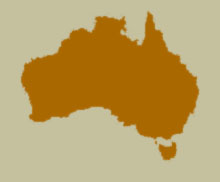Synonyms
Bucolus caesariatus Slipinski and Dolambi, 2007:765.
Diagnosis
This species differs readily from all remaining species of Bucolus by the convex body and golden-yellowish pubescence on pronotum and elytra. It strongly resembles specimens of Erithonyx Blackburn but differs in having an anterior prosternal projection, externally angulate tibiae and form of the abdominal postcoxal line.
Description
Length 3.5-4.6 mm. Colour dark brown to almost black; mouthparts, antennae, tarsi and abdomen brown. Dorsum distinctly convex, covered with long and dense, golden-yellowish pubescence not forming patterns on elytra. Punctures on head distinctly finer than eye facets, separated by 1.5-2.5 diameters; intervals between punctures shiny without noticeable microsculpture. Anterior clypeal margin straight. Antenna long and slender with loose club. Apical maxillary palpomere, subquadrate and not expanded. Eyes at frons separated by about 2.0-2.2 times eye width. Pronotal base finely margined in front of scutellum only. Prosternum very short in front of procoxae; prosternal projection weak and less than 0.3 times as broad as prosternum. Prosternal process narrow, 0.3 times as wide as transverse coxal diameter. Hypomeron concave but without distinct foveae. Scutellum pentagonal, setose. Metaventral postcoxal lines arcuate, not extending on metepisternum. Elytral surface irregularly and singly punctate; setigerous punctures about as large as the pronotal ones, 1.0-1.5 diameters apart; interspaces shiny and without noticeable microsculpture. Epipleuron about 2 times as broad as metepisternum, strongly narrowing posteriorly from the level of abdomen and completely absent from about level of ventrite II; foveae very weakly defined. Meso-metaventral junction 0.5 times as wide as mesocoxa; mesoventrite arcuate and weakly bordered anteriorly. All legs rather narrow and long, with tibiae weakly angulate externally; claws in both sexes appendiculate with basal tooth prominent and sharp. Abdominal postcoxal line recurved and complete; ventrite V straight or arcuate.
Male
Male genitalia as figured.
Female
Externally identical to male.
Variation
UNDER CONSTRUCTION
 Distribution and Biology
Distribution and Biology
Known from a few widely scatteredlocalities in southern Queensland and New South Wales.
Species References
Slipinski, A and Dolambi, F. 2007.Revision of the Australian Coccinellidae (Coleoptera). Part 7. Genus Bucolus Mulsant. Annales Zoologici (Warszawa), 57: 763-781.
[ Top ]
